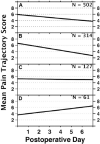AAAPT: Assessment of the Acute Pain Trajectory
- PMID: 33735384
- PMCID: PMC7971475
- DOI: 10.1093/pm/pnaa440
AAAPT: Assessment of the Acute Pain Trajectory
Abstract
Objective: Define and contrast acute pain trajectories vs. the aggregate pain measurements, summarize appropriate linear and nonlinear statistical analyses for pain trajectories at the patient level, and present methods to classify individual pain trajectories. Clinical applications of acute pain trajectories are also discussed.
Setting: In 2016, an expert panel involving the Analgesic, Anesthetic, and Addiction Clinical Trial Translations, Innovations, Opportunities, and Networks (ACTTION), American Pain Society (APS), and American Academy of Pain Medicine (AAPM) established an initiative to create a pain taxonomy, named the ACTTION-APS-AAPM Pain Taxonomy (AAAPT), for the multidimensional classification of acute pain. The AAAPT panel commissioned the present report to provide further details on analysis of the individual acute pain trajectory as an important component of comprehensive pain assessment.
Methods: Linear mixed models and nonlinear models (e.g., regression splines and polynomial models) can be applied to analyze the acute pain trajectory. Alternatively, methods for classifying individual pain trajectories (e.g., using the 50% confidence interval of the random slope approach or using latent class analyses) can be applied in the clinical context to identify different trajectories of resolving pain (e.g., rapid reduction or slow reduction) or persisting pain. Each approach has advantages and disadvantages that may guide selection. Assessment of the acute pain trajectory may guide treatment and tailoring to anticipated symptom recovery. The acute pain trajectory can also serve as a treatment outcome measure, informing further management.
Conclusions: Application of trajectory approaches to acute pain assessments enables more comprehensive measurement of acute pain, which forms the cornerstone of accurate classification and treatment of pain.
Keywords: Acute Pain; Latent Class Analyses (LCA); Random Intercept; Random Slope; Trajectory.
© The Author(s) 2021. Published by Oxford University Press on behalf of the American Academy of Pain Medicine.
Figures






References
-
- Kent ML, Tighe PJ, Bruehl S, Turk DC, Dworkin RH.. The ACTTION-APS-AAPM Pain Taxonomy (AAAPT) diagnostic criteria for acute pain conditions: An introduction. J Pain 2019;20(7):743–5. - PubMed
Publication types
MeSH terms
Grants and funding
LinkOut - more resources
Full Text Sources
Other Literature Sources
Research Materials
Miscellaneous

